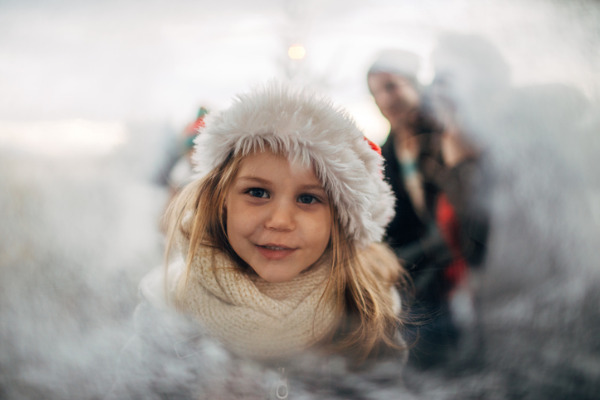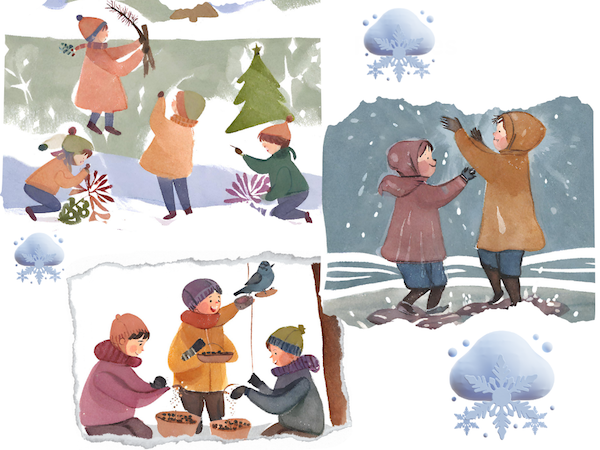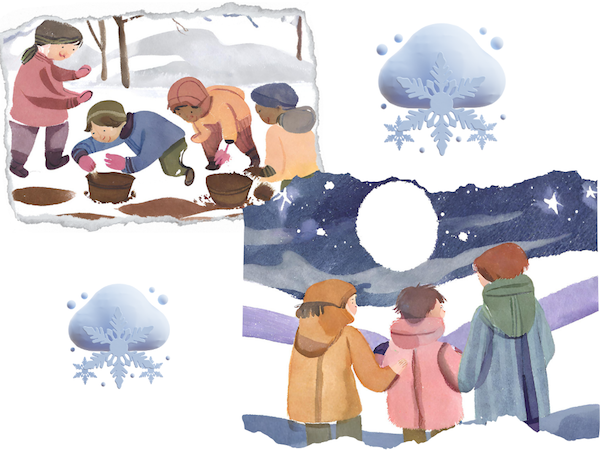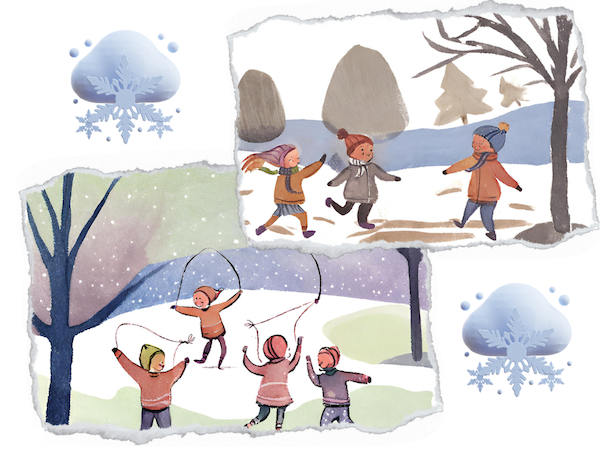Yes, it may be cold but you can still embrace outdoor activities during the winter. Joanna Feast emphasises the many benefits of spending time outside, including mood improvement, stress relief and enhanced connections with nature and emotions.

'Oh, the weather outside is frightful, but the fire is so delightful!'
As we inch closer to the Christmas break, these song lyrics might feel apt: staying indoors and out of the weather can feel very tempting. And there is nothing wrong with that. But let's not write off being outside at this time of year, as there is so much on offer to interest and delight.
Here are some ideas to kick-start your winter adventures. They can simply be ways to encourage children to be outside or you could easily apply many of them to curriculum areas.
Make some natural indoor and outdoor decorations by collecting evergreen foliage. You could twine them to make a wreath or drape them for garlands. Adding greenery indoors lifts a space and provides vibrant colours and sometimes festive scents too, particularly if you choose pine-type foliage. Be careful to remove any berries and the like if you have small children present.

Small children and puddles are an excellent combination. As long as children wear the appropriate clothing, the puddle-jumping fun can last for hours!
With fewer leaves on the trees, it can be easier to watch the birds. If you want to keep children engaged for longer than a few minutes, make a simple bird-spotting bingo card with pictures and/or names of birds that are common in your area. When children spot them, they can mark them off the bingo card one by one.
Speaking of birds, this is a great time of year to make a bird feeder and keep it topped up until spring. There are many instructions available online to help you get started. The tips will help you choose the correct type of feed for the birds in your area – whether you're in a town, city or the countryside.
Make the most of the mud and create a mud kitchen outdoors. Use old pans, containers and utensils to create mud pies, soups and stews. Children will generally stay warm and dry if they dress appropriately for the activity.

Celebrate the dark skies and try some star-gazing. If you have space to do this, set up your viewing station during the day so it's ready for the evening: you could use sun loungers/camping mats and blankets to lie on and stay cosy. (If you don't have them, you could stand up or use any available chairs.) You might like to have a warm drink handy. You could watch out for shooting stars too – with the first person to spot one winning a small prize. Many free apps are available that help you identify what you're looking at in the dark sky to help keep the interest up.
On frosty mornings, nature rewards us with an array of beauty – from spiders' webs to grass and leaves – so spend some time marvelling at the intricacies of Jack Frost's work. Take some photos, make an outdoor collage (before it melts) or listen to the sound of crunching over the frosty ground, making patterns with footprints as you walk. Some children might like to play Dragon's Breath, where they see who can exhale their breath (that they can now see in the cold air) for the longest.
If it does snow, there is not much adults can do for children to increase their excitement levels! Children must be dressed warmly and appropriately for spending time in the snow – gloves/mittens, hats, scarves, coats, boots and plenty of layers that children can remove as they generate their own heat (and can put back on for the journey back).

If you feel confident and have the training to do this (if you are working in a school), teach children how to light a fire safely. Once you have lit the fire, you can share stories, heat up snacks, sing songs and dance around the fire – at a safe distance, in a well-managed way.
If a fire isn't possible, generate your own heat by engaging children in various outdoor games. Skipping is an excellent way to keep warm, whether you have an individual rope or are turning a bigger rope for others to jump in. There are many skipping game suggestions online if children's interest wanes quickly. Alternatively, you could try some singing games and haul out some old favourites like the 'Hokey cokey' or 'Heads, shoulders, knees and toes', gradually increasing the speed to ensure everyone keeps moving.
Go on a winter walk and see what items of interest you can collect. To give this activity more purpose, suggest to children that they can collect five different leaves, four berries (not for eating), three pine cones and so on. If you think they will work well under timed conditions, you could give them 10 minutes to find as much as they can from the list and return with the fruits of their search to share with the rest of the group. Working in small teams can help children to collaborate and encourage the less enthusiastic to be involved.
And if it takes more to convince you to venture outside, you might be interested to know that being in nature at any time of year has a dazzling array of benefits. It's well-documented now that being outside can help improve your overall mood; it can reduce feelings of anger and loneliness – something that is quite common at this time of year.
Being outdoors helps people of any age feel more connected with nature – a natural stress reliever – and feel more connected with our feelings too. Just a few minutes on one day is enough to start the benefits working for you and your pupils.

Help children grow in confidence and skills through learning outside.